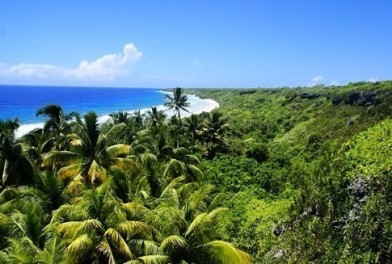
Henderson Island, one of the four islands making up the Pitcairn Islands. Photo credit: Andrew Christian.
ON A DISTANT beach in the South Pacific, waves lap against a shoreline shaded by palm trees and a dense thicket of twisted shrubs. Under the canopy, an assortment of tiny crustaceans scuttles amongst the mounds of seaweed and derelict shells that litter the white sand, avoiding the beaks of hungry seagulls.
Such is the shoreline of the remote and idyllic Pitcairn Islands.
Located in a distant corner of the South Pacific, this remote archipelago is isolated from South America, the nearest continent, by over three thousand miles of open water. With only 54 inhabitants, the islands are one of the few unspoiled natural landscapes left on the planet.
Or so one would think. A stroll along the picturesque beaches reveals more than shells and seaweed strewn about the sand.
The beaches are also littered with… litter.
A quick glance at Google Street View shows a shoreline covered with Styrofoam containers, fishing buoys, nets, and plastic detritus of all shapes and sizes. If you take virtual stroll along the beach, you can easily see how drastic a problem marine debris is.
The degradation of the Pitcairn shoreline is not unique. The beaches of many otherwise pristine Pacific islands, including the American Midway Islands and the Australian Lord Howe Island, are clogged with trash.
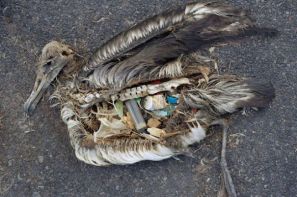
The carcass of a seabird filled with previously ingested plastic fragments. Up to 90% of seabirds have plastic in their guts. Photo credit: Chris Jordan.
Plastic pollution in the oceans and along the coast is problematic for several reasons.
Pitcairn and other islands serve as important nesting sites for seabirds, which come to rest and lay eggs in huge colonies. Plastic debris are often fatal when ingested and have been implicated in the population decline of over 700 marine species, from seabirds and fish to sea turtles and marine mammals.
To make matters worse, nearly every plastic that has ever been synthesized still exists in some artificial form. While UV light and wave action fragment plastic pollution, those particles retain the chemical properties of plastic and are toxic to wildlife. Because plastic doesn’t biodegrade, marine plastics will persist in the ecosystem for thousands of years.
It is estimated that the ocean harbors 315 billion pounds of plastic. That’s roughly equivalent to the weight of half of the world’s population.
This plastic pollution, however, is not evenly distributed throughout the ocean. As the shores of Pitcairn fill with debris that originated thousands of miles away, other regions of the ocean have relatively little marine debris, as seen below.

Each white dot on the map above symbolizes 20 kg of marine plastic debris. While plastic pollution is often concentrated in the center of ocean basins and along coastlines, certain regions of the ocean contain relatively little plastic pollution. You can explore the interactive map here. Photo credit: Sailing Seas of Plastic.
Global ocean currents concentrate plastic pollution in a series of rotating eddies, known as gyres, located in the center of large ocean basins. These gyres are colloquially known as garbage patches, and five are known to exist worldwide.
While the term “garbage patch” invokes images of a floating landfill, such imagery is misleading. In reality, marine debris often lie suspended out of sight mere feet below the surface, dispersed across oceanic gyres that are each the size Texas.
The sheer scale of the garbage patches and the diffuse nature of the plastic particles have been major obstacles to the scientists, innovators, and environmentalists seeking to clean them up. Several ideas have been pitched for cleaning these remote patches of ocean, but so far all have been prohibitively expensive and impractical.
With the plastic floating in the garbage patches effectively out of reach, is marine plastic pollution an insurmountable problem? Are there any practical clean up solutions?
A Targeted Approach
Every year, thousands of ocean lovers, environmental enthusiasts, and global citizens travel to the beach to search for marine debris. Over the past three decades, this dedicated group of 11.5 million volunteers from more than 150 countries has collected 200 million pieces of marine debris from beaches around the world.
But this annual effort, called the International Coastal Cleanup and organized by the Ocean Conservancy, is not your average beach cleanup. It is a unique and invaluable citizen science initiative with the power to change the conversation on marine plastic pollution.
To paint a more accurate picture of coastal marine pollution, International Coastal Cleanup volunteers report the size, type, and location of each piece of plastic they collect to the Ocean Conservancy. The resulting data set is unprecedented in scale and is being used to study trends in marine plastic pollution.
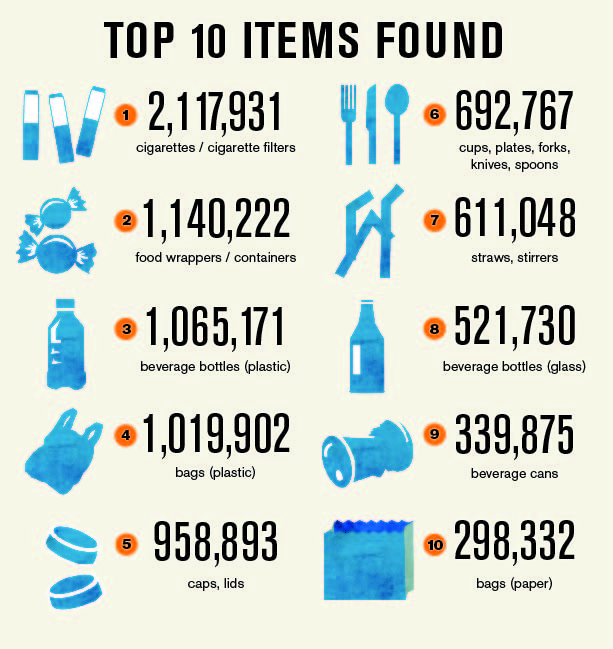
The most common types of plastic pollution collected during the Ocean Conservancy’s International Coastal Cleanup. Photo credit: The Ocean Conservancy.
Marine pollution is such a widespread problem that focusing time and resources on all regions and types of debris may not be the most effective approach. But with information about the deadliest types of plastic and the regions most affected by them, policy makers and scientists can take impactful steps to clean the ocean and make a difference.
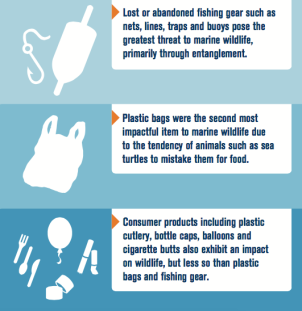
Fishing gear and plastic bags are the most harmful types of debris for marine wildlife. A targeted effort to address derelict fishing gear and reduce plastic bag consumption would have a greater net gain for marine life compared to a general anti-litter campaign. Photo credit: The Ocean Conservancy.
For example, data from beach cleanups and other plastic research initiatives has shown that plastic bags are among the most common and deadliest types of marine debris. This finding highlights the conservation benefits of banning or taxing plastic bags. And additional research on the distribution of marine trash, which shows that Southeast Asia, the United States, eastern Australia and southern Africa are hot spots for plastic bag ingestion by sea turtles, pinpoints regions where those efforts could have maximum efficacy.
Targeting the most ecologically harmful plastics as well as those that can be phased out with the greatest ease will net the greatest benefit for marine ecosystems and ocean health.
Marine debris can be targeted in several ways. Policies aimed at behavior change such as recycling programs, public awareness campaigns, and consumer regulations are commonly used strategies.
Bag taxes have been shown to reduce plastic bag consumption by up to 50% and lead to permanent behavior modification. Regulatory policies that discourage smoking indirectly reduce the amount of discarded cigarette butts. And while the practice of banning specific plastics outright is rare, President Obama’s decision to ban microplastics in early 2016 was an important step in the right direction.
Another approach involves replacing non-biodegradable products and packaging with biodegradable alternatives. From utensils and packing peanuts made of plant starch to Styrofoam substitutes made from mushrooms, bioalternatives have immense potential as a tool for reducing marine debris.
In addition to the preventative measures described above, beach cleanups serve the important function of removing existing marine debris. Research on marine plastic has shown that rotating gyres eject 50% of their contents with each rotation. This ejected plastic is either sucked up into other oceanic currents or deposited back on the shoreline. Since the sea and the shore are connected, cleaning beaches also acts to clean oceanic gyres and eliminates the need to filter plastic particles on the high seas.
What YOU can do
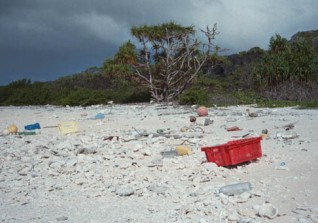
Plastic pollution on the the Pitcairn Islands. Because of the interconnectivity of the sea and the shore, picking up beach plastics is equivalent to recovering marine plastics. Ecologically sensitive beaches, shorelines next to strong currents, and areas with high concentrations of plastic pollution are beach cleanup priorities. Photo credit: Thesalmons.org
Biomaterials, beach clean-ups, and targeted regulations all play important roles in the fight against marine debris, and the ultimate solution will surely require a combination of approaches.
But keeping the oceans clean requires more than a targeted campaign against the deadliest or most prevalent types of plastic pollution. It requires all of us to change the way we view and consume plastic.
The average American throws away 185 pounds of plastic each year, and roughly 50% of the plastic consumed is used only once before being tossed. Over the course of the last decade, more plastic has been produced and consumed than during the entirety of the last century. And on a global scale, enough plastic is thrown away each year to encircle the Earth four times.
For the sake of the ocean, these statistics need to change. Our relationship with plastic needs to change.
If you recycle, that is an important first step. But recycling is the last step in the “reduce, reuse, recycle” mantra for a reason: it is an energy intensive process that facilitates the production of more plastic. To really make a difference, public focus needs to shift towards reducing and reusing plastic waste.
There are a number of easy things you can do to reduce your personal plastic footprint.
- Shop with reusable grocery bags and skip bags altogether when you purchase just a handful of items.
- Drink from a reusable water bottle instead of purchasing bottled water.
- Reuse containers for storing leftovers and pack your lunch in Tupperware instead of plastic bags.
- If two products are similar, buy the one that uses less packaging, and buy in bulk when possible.
- Avoid single use plastic products such as straws, cutlery, and lids.
- When ordering carryout, ask for a biodegradable container instead of plastic or Styrofoam.
- Learn to cook: the average home cooked meal generates far less plastic waste than preprocessed or frozen food.
- Pick up after yourself and others. Next time you go for a walk, bring a bag and collect plastic you see lying around that is easily accessible.
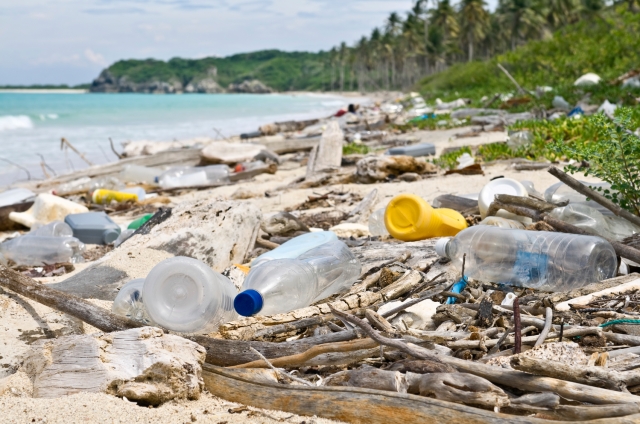
Photo credit: iStock.
LEARN MORE
- Sign up to take part in Ocean Conservancy’s International Coastal Cleanup
- Check out this interactive map of marine plastic pollution
- 93% of Americans tested positive for chemicals found in plastic
- An interactive guide to marine plastic pollution, by SloActive


[…] photosphere of a penguin colony in Antarctica, or even “walk” along the tropical beaches of the Pitcairn Islands in the middle of the Pacific […]
LikeLike
[…] in 2015 and created the largest contiguous marine reserve in the world. The new MPA encompasses the Pitcairn Islands, an overseas British territory in the South Pacific with only 56 inhabitants. At 2,000 km from the […]
LikeLike
[…] of pounds of plastic currently clog the ocean in the form of bags, water bottles, wrappers, and micro-plastic […]
LikeLike
Yes. If we can fly man and woman to space, we can rid the oceans of plastic.
Best Wishes
Tony Powell and naturestimeline
LikeLiked by 1 person
[…] billion pounds of cigarette butts wash into our oceans, lakes, and rivers, making cigarettes the most prevalent form of marine debris worldwide. Cigarette pollution is a serious problem, not just because smokers so often dispose of used […]
LikeLike
[…] Is marine plastic pollution a solvable problem? […]
LikeLike
[…] However, species like the Hawaiian monk seal, which face a combination of threats including marine debris, habitat loss, disease, and climate change, have been slower to […]
LikeLike